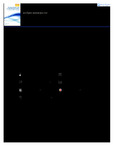Development of writing task recombination technology based on DMP segmentation via verbal command for Baxter robot
| dc.contributor.author | Li, C | |
| dc.contributor.author | Yang, C | |
| dc.contributor.author | Annamalai, A | |
| dc.contributor.author | Xu, Q | |
| dc.contributor.author | Li, S | |
| dc.date.accessioned | 2020-07-09T05:37:19Z | |
| dc.date.available | 2020-07-09T05:37:19Z | |
| dc.date.issued | 2018-08-14 | |
| dc.identifier.issn | 2164-2583 | |
| dc.identifier.issn | 2164-2583 | |
| dc.identifier.uri | http://hdl.handle.net/10026.1/15863 | |
| dc.description.abstract |
This paper developed a character recombination technology based on dynamic movement primitive (DMP) segmentation using verbal command on a Baxter robot platform. Movements are recorded from a human demonstrator. The operator physically guides the Baxter robot to perform the movements for five times. This training data set is also utilized for playback process. Subsequently, the dynamic time warping is employed to pre-treat the data. The DMP is used to model and generalize every single movement. Gaussian mixture model is used to generate multiple patterns after the teaching process. Then the Gaussian mixture regression algorithm is applied to reduce the position errors in 3D space after the generation of a synthesized trajectory. A remote PC is used to control the command of Baxter to record or playback any trajectories via user datagram protocol (UDP) by typing commands in a text file. In addition, Dragon NaturalSpeaking software is used to transfer the voice data to text data. This proposed approach is tested by performing a Chinese character writing task with a Baxter robot, where different Chinese characters are written by teaching only one character. | |
| dc.format.extent | 350-359 | |
| dc.language | en | |
| dc.language.iso | en | |
| dc.publisher | Informa UK Limited | |
| dc.subject | Task recombination | |
| dc.subject | segmentation | |
| dc.subject | dynamic time warping | |
| dc.subject | dynamic movement primitive | |
| dc.subject | Gaussian mixture regression | |
| dc.subject | teaching | |
| dc.title | Development of writing task recombination technology based on DMP segmentation via verbal command for Baxter robot | |
| dc.type | journal-article | |
| dc.type | Article | |
| plymouth.issue | 1 | |
| plymouth.volume | 6 | |
| plymouth.publication-status | Published | |
| plymouth.journal | Systems Science & Control Engineering | |
| dc.identifier.doi | 10.1080/21642583.2018.1509397 | |
| plymouth.organisational-group | /Plymouth | |
| plymouth.organisational-group | /Plymouth/Faculty of Science and Engineering | |
| plymouth.organisational-group | /Plymouth/Faculty of Science and Engineering/School of Engineering, Computing and Mathematics | |
| plymouth.organisational-group | /Plymouth/REF 2021 Researchers by UoA | |
| plymouth.organisational-group | /Plymouth/REF 2021 Researchers by UoA/UoA11 Computer Science and Informatics | |
| plymouth.organisational-group | /Plymouth/Users by role | |
| plymouth.organisational-group | /Plymouth/Users by role/Academics | |
| dcterms.dateAccepted | 2018-08-05 | |
| dc.rights.embargodate | 2020-7-15 | |
| dc.identifier.eissn | 2164-2583 | |
| dc.rights.embargoperiod | Not known | |
| rioxxterms.versionofrecord | 10.1080/21642583.2018.1509397 | |
| rioxxterms.licenseref.uri | http://www.rioxx.net/licenses/all-rights-reserved | |
| rioxxterms.licenseref.startdate | 2018-08-14 | |
| rioxxterms.type | Journal Article/Review |


